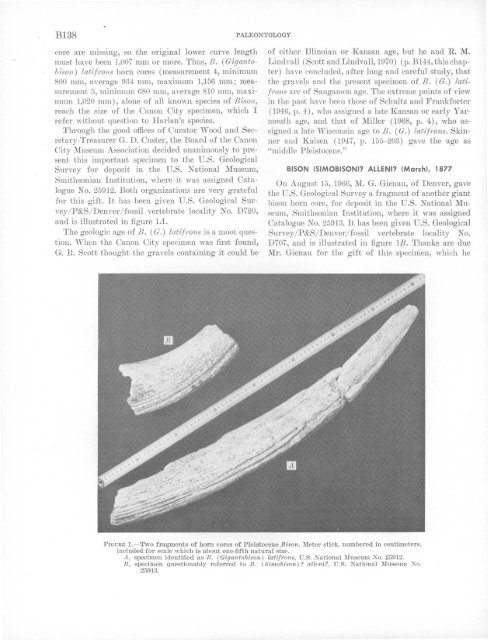RESEARCH· ·1970·
RESEARCH· ·1970·
RESEARCH· ·1970·
You also want an ePaper? Increase the reach of your titles
YUMPU automatically turns print PDFs into web optimized ePapers that Google loves.
B138<br />
PALEONTOLOGY<br />
core are m1ssmg, so the original lower curve length<br />
must have been 1,007 mm or more. Thus, B. ( Gigantobison)<br />
latif1'0ns horn cores (measurement 4, minimmn<br />
800 mm, average 934 mm, maximum 1,156 mm; measurement<br />
5, minimum 680 mm, average 810 mm, maximum<br />
1,020 mm), alone of all known species of Bison,<br />
reach the size of the Canon City specimen, which I<br />
refer without question to Harlan's species.<br />
Through the good offices of Curator \Vood and Secretary-Treasurer<br />
G. D. Custer, the Board of the Canon<br />
City Museum Association decided unanimously to present<br />
this important specimen to the U.S. Geological<br />
Survey for· deposit in the U.S. National Museum,<br />
Smithsonian Institution, where it \Yas assigned Catalogue<br />
No. 25912. Both organizfLtions rure very grateful<br />
for this gift. It has been given U.S. Geological Survey/<br />
P&S/ Denver/ fossil vertebrate locality No. D720,<br />
and is illustrated in figure lA.<br />
The geologic age of B. (G.) latif1·ons is a moot question.<br />
When the Canon City specimen was first found,<br />
G. R. Scott thought the gravels containing it could be<br />
of either Illinoian or Kansan age, but he and R. M .<br />
Lindvall (ScottandLindv,all, 1970) (p. B144, this chapter)<br />
l1aYe concluded, after long·and careful study, that<br />
the gravels and the present specimen of B . (G.) lati<br />
/1'0ns are of Sangamon age. The extreme points of view<br />
in the past have been those of Schultz and Frankforter<br />
(1946, p. 4), who assigned a late Kansan or early Yarmouth<br />
age, and that of Miller (1968, p. 4.), who assigned<br />
a late Wisconsin age to B. (G.) latif1'0ns. Skinner<br />
and Kaisen (1947, p. 155-203) gave the age as<br />
"middle Pleistocene."<br />
BISON (SIMOBISONl? ALLENI? (Marsh), 1877<br />
On August 15, 1966, M. G. Gienau, of Denver, gave<br />
the U .S. Geological Survey a fragment of another giant<br />
bison horn core, for deposit in the U.S. National Museum,<br />
Smithsonian Institution, where it was assigned<br />
Catalogue No. 25913. It has been given U.S. Geological<br />
Survey/P&SjDenver/ fossil vectebrrute locality No.<br />
D707, and is illustrated in figure lB. Thanks ar.e due<br />
Mr. Gienau for the gift of this specimen, which he<br />
FIGURE 1.-Two f ragments of horn cores of P leistocene Bison. Meter stick, numbered in centimeters,<br />
included for scale which is about oce-fifth natural size.<br />
A, specimen identified as B . (Gigantobison) latif?·ons, U.S. Xational Museum ~o. 25912.<br />
B, specimen questionably referred to B. (Simob·ison) 'I alleni?, U.S. National Museum Xo.<br />
25913.
















